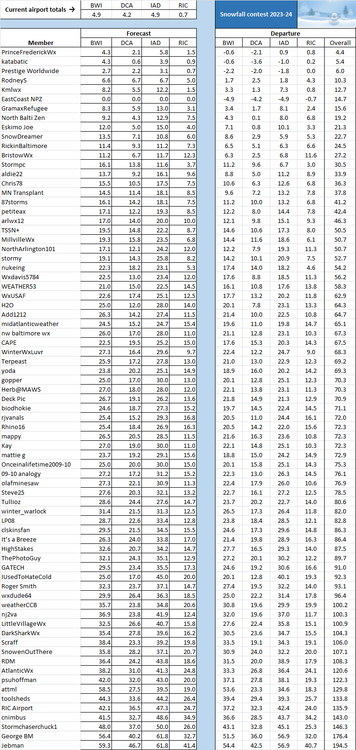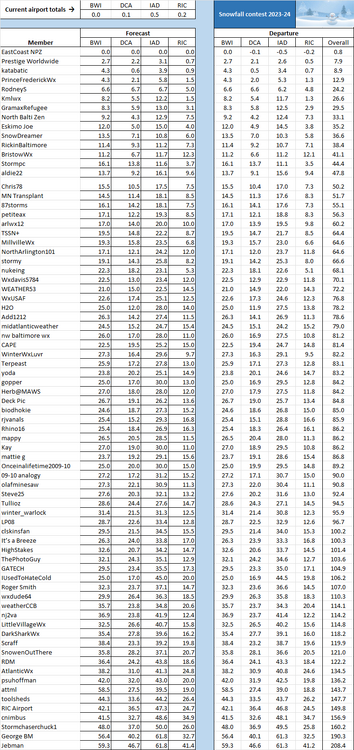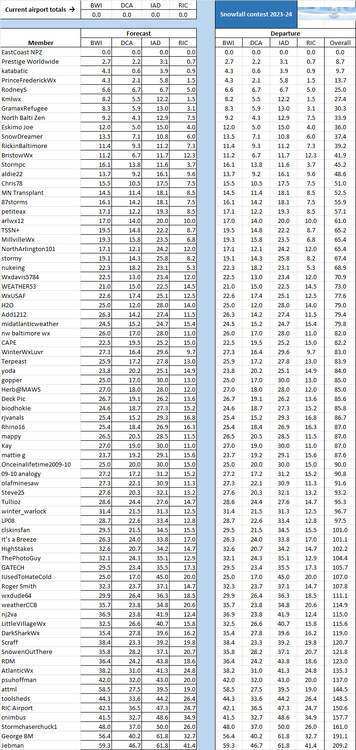
RodneyS
Members-
Posts
1,374 -
Joined
-
Last visited
Content Type
Profiles
Blogs
Forums
American Weather
Media Demo
Store
Gallery
Everything posted by RodneyS
-
We indeed have a new leader -- previous Mid-Atlantic snow contest operator @PrinceFrederickWx. So far, the reports for this storm are as follows: BWI 4.9 inches DCA 4.1 inches IAD 4.4 inches RIC 0.5 inches There still may be updates to these figures, but the table below shows the current standings.
-
I see that as of 1 PM today (Monday, MLK day), DCA is reporting 0.7 inches and IAD is reporting 0.9 inches. By tomorrow morning, we should have a new leader -- something that did not happen last season ;-). I will update the leader board on Tuesday.
-
Interesting note from the Capital Weather Gang: "The 2.24 inches at Reagan National Airport, 1.76 inches at Dulles International Airport, and 2.62 inches at Baltimore-Washington International Marshall Airport were all record amounts for the date. That brings Washington’s total rainfall to 9.69 inches since Dec. 1, well past the previous high of 7.56 inches during the same period in 1901-1902, according to Capital Weather Gang’s Ian Livingston." See https://www.washingtonpost.com/weather/2024/01/10/dc-storm-flooding-record-rainfall
-
2023 gave it a good try, but could not quite catch 2012 for the warmest calendar year ever in DC. December 2023 at DCA finished at 45.5 degrees, tied for the 5th warmest December in DC history. However, that brought the yearly average only to 61.3 degrees, vs 61.6 in 2012. 2023 did displace 2017 (60.8) as the 2nd warmest in DC history.
-
Based on the numbers from the Capital Weather Gang, RIC Airport, and yoda, below is the updated spreadsheet. EastCoast NPZ is still in the lead, but he does have an unwanted distinction that no one achieved last season: Negative departures at DCA, IAD, and RIC.
-
Thanks. So RIC and IAD (0.5 inches) have exceeded last season's snow totals. I have not yet heard about measurable snow at BWI or DCA. I will update the spreadsheet when I do.
-
Thanks, Herb. I know that the Capital Weather Gang had one of their better snow forecasts for 2009-10, but I'm not sure anyone foresaw the record amount of snow that season.
-
Thanks, Roger. I wonder if anyone ran a Mid-Atlantic contest on any Internet site in 2009-10? If so, were the picks abnormally high?
-
Are you already regretting not following through on your below statement of November 10th? Just waiting til the last possible minute to go .1 across the board…
-
BWI: 25.5 DCA: 18.4 IAD: 28.1 RIC: 13.5
-
For the 2023-24 snow season contest, we have 75 entrants, up from 64 in 2022-23. Assuming that none of last season's entrants changed their user names, 49 entrants this season are returnees and 26 are new. The average amount forecast for the four airports combined this season is 85.6 inches, up from 63.3 last year. The median is also 85.6 inches, up from 58.9 last year. Below is the summary table, listed in ascending order of the snow forecast at the four airports combined:
-
This snow season my strategy consisted of: 1) 1% inspiration 2) 1% perspiration 3) 98% dart throwing.
-
Lock Day 2023 has arrived, and so 11:59 PM EST is the last chance to submit or modify your entry. Here is mine: BWI: 6.6" DCA: 6.7" IAD: 6.7" RIC: 5.0" Tiebreaker: SBY: 2.2"
-
Thank you @AtlanticWxfor adding Richmond.
-
November 2023 at DCA came in slightly below the 1991-2020 normal, at 49.6 degrees, which was higher than November 2012 (46.6), but lower than November 2017 (49.8). So, the first 11 months of 2023 gained a little on 2012, but edged further behind 2017, with an average temperature of 62.7 degrees versus 63.1 for the first 11 months of 2012 and 62.8 for the first 11 months of 2017. However, because December 2012 was quite warm at DCA (45.3) and December 2017 was relatively cold there (39.2), 2023 will very likely finish behind 2012, while probably finishing ahead of 2017. Specifically, if December 2023 averages between 40.4-49.1 degrees at DCA (1991-2020 normal is 41.7), 2023 will finish as the second warmest calendar year in DC history. For 2023 to beat 2012 as the warmest calendar year in DC history, December 2023 at DCA would have to be the second warmest meteorological winter month in DC history, behind only December 2015 (51.2)
-
Paging @AtlanticWx, I need your snow forecast for RIC in the below thread. You did not supply that number, and you cannot receive private messages.
-
Reminder: This is the final week to enter the contest. Entries will lock Friday at 11:59 PM EST.
-
Thanks, but I need a number for RIchmond.
-
It would appear that integrating AI with traditional models could improve the latter. For example, if AI is forecasting snowstorms for a given area more accurately than traditional models, that may indicate that traditional models are paying insufficient attention to historical data that could inform the models.
-
Thanks.
-
Okay, but I need a tiebreaker for only one of the two airports, in the event that you and another contestant tie for 1st place when the contest ends. So, why don't you choose from one of these two midpoints: Lynchburg 13.5 inches or Salisbury 10.5 inches?
-
Do you have a tiebreaker for Salisbury or Lynchburg?
-
Do you have a tiebreaker (either Salisbury or Lynchburg)?







